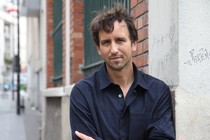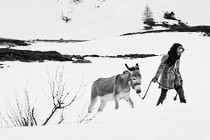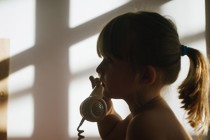Review: Cléo & Paul
- BERLIN 2018: The sophomore feature by France’s Stéphane Demoustier is a striking, claustrophobic odyssey through the streets of Paris, seen through the eyes of a lost child

The Generation competition of the Berlin Film Festival has hosted the premiere of one of the true little gems selected for the German gathering. After his feature debut, 40-Love [+see also:
trailer
film profile] (presented in the International Critics’ Week of the Venice Film Festival in 2014), French filmmaker Stéphane Demoustier is back to stun us with Cléo & Paul [+see also:
trailer
film profile], another family drama, although on this occasion, the core of the family has been pared down to just two members. More specifically, they are two siblings (aged between three and five years old) forced to endure a traumatic separation.
The brief prologue to Cléo & Paul takes place in a crowded park, where the little ones are amusing themselves by playing hide-and-seek. Their elderly nanny (Elsa Wolliaston) is unable to partake in the game because of her limp. But despite her lack of mobility, the woman does everything she can to track their movements, keeping an eye on them from a distance, sat on a bench. But her efforts are not good enough, because Cléo and Paul are so engrossed in the game that they stray too far. The little tykes manage to hide so effectively that they never set eyes on each other again. After getting lost, the siblings take different paths: Paul heads off in search of their nanny, while Cléo wanders the streets and gardens of Paris alone and in a state of utter disorientation. From that moment on, the plot of Cléo & Paul doubles up, as one camera follows Cléo, another Paul.
Cléo & Paul is a traumatic odyssey that we experience through the eyes of a child. It is worth noting that the camera is always kept at the same height as the protagonists, except when they – especially Cléo – interact with adults. Demoustier only uses medium or long shots when the little ones are sharing the scene with grownups who are in some way important to the plot development. In this sense, the positioning of the camera is an element that creates a feeling of heightened anxiety in the movie, as it helps to adopt the appropriate point of view and expand on a subjective story through the blank stare of a three-year-old child.
At the film’s halfway point, the appearance of the character of Louise (played by Vimala Pons) will steal all the limelight away from our diminutive heroes. When Cléo starts playing with the first stranger she comes across, there will be no turning back for Louise. At first, Demoustier leads us to believe that he has introduced Louise’s character to keep the tragedy to a minimum, because she is the one person who can lead Cléo back to her brother, her nanny or her parents (who always remain out of shot). But in fact this will not be possible, as the policemen in the park and the soldiers strolling around with semiautomatic weapons on account of the terrorist alert are forbidden from abandoning their posts, even to help Louise. Thus, when the adults start playing a role in the drama and the children take a back seat in the action, the film turns into an uncomfortable morality tale about the selfishness of grownups.
Cléo & Paul was produced by French outfits Année Zéro and Tripode Productions. Stray Dogs is in charge of its international sales.
(Translated from Spanish)
Did you enjoy reading this article? Please subscribe to our newsletter to receive more stories like this directly in your inbox.

























